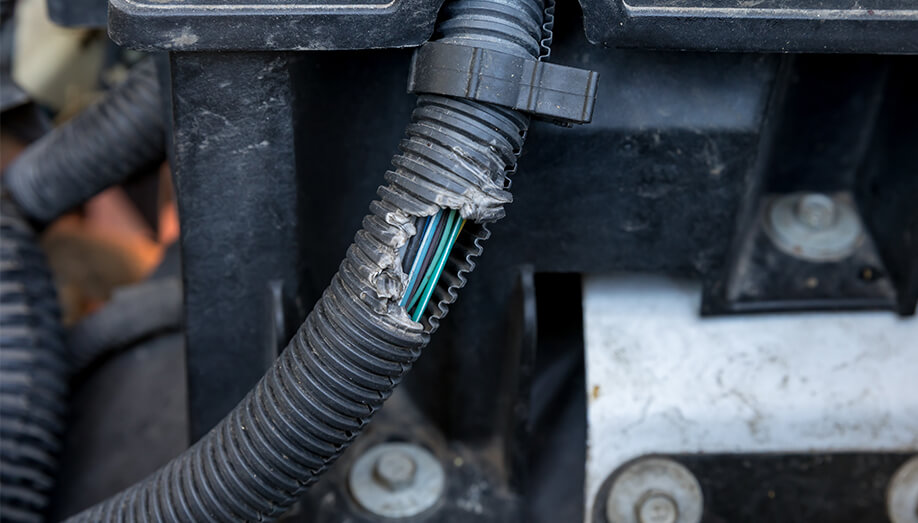
Keeping rats and mice out of your car can be a tricky endeavor for homeowners and pest control professionals alike. The damage caused by rodents in the cab and engine compartment of a vehicle can total in the thousands of dollars; your safety and the safety of your passengers can certainly be at risk as well.
Let’s explore the reasons why rodents take harborage in vehicles, the damage they can cause, and how you can help keep rodents out of your car!
Why Do Rodents Get Into Your Car?
Your car or truck can be an extremely attractive place for rats and mice to live, search for food and hide from nearby predators. In addition to these three primary reasons, there are other contributing factors add to the allure of a vehicle and its use by rats and mice.
When extreme cold temperatures hit, the engine compartment of a car can be a great place for rodents to stay warm. Once chewed, the upholstery and other fabrics make for perfect nesting material, further sheltering rodents from the cold.
Where you park your vehicle can have a big impact on the risk you run as well. Parking next to food sources and areas of ideal rodent harborage increase the odds of having an infestation; the closer you park to areas with dumpsters, gardens, bird feeders, chicken coops, or blackberry bushes, the more you put your vehicle at extreme risk.
Odor can also play a role in whether or not rodents decide to explore your car or truck. Leaving food or food wrappers inside the cab will certainly draw attention. A vehicle that has been infested for a significant length of time will be covered with urine and droppings, which can signal to other rodents that a particular location is ideal.
Vehicles built in 2008 and newer have a unique allure for rats and mice. Many car and truck manufacturers have gone to using bio-plastics in order to save money and become more eco-friendly. That might sound great, but there is a downside: the wiring harnesses in these vehicles are made of a specific bio-plastic that is a soy derivative, which is extremely attractive for rats, mice and squirrels. Many of us have fallen victim, and had wiring harnesses and other items in our vehicles damaged or destroyed as a result.
What Kind of Damage Can Rodents Do to Your Car?
Rodents can cause both cosmetic and mechanical damage to your car, and there are health and safety concerns that need to be considered as well.
Rats and mice are vectors of some serious diseases, including hanta virus, salmonella, and leptospirosis. A vehicle’s air filter is a common place for rodents to nest once they’ve made entry; if that happens, every time you turn the heating/air conditioning on, you’re pushing fecal particulates, dander, and other rodent nasties into the cab of your vehicle for any occupant to breathe. Even if it’s not spreading disease, many allergies are triggered by the dirt, dust, and dander that rodents introduce.
Mechanical malfunctions caused by rodent damage can range from relatively innocuous to serious and life-threatening. If the radio doesn’t turn on as the result of a chewed wire, it’s little more than an inconvenience; if your engine gets choked off as a result of a blockage from nesting materials, it can take a good bit of money to fix the problem. If your brakes or power steering goes out because a rodent has rendered those systems inoperable, the lives of you or your passengers could be at stake.
There are certain risk factors and signs of rodent activity to be on the lookout for, including:
- Chewed wires, hoses, filters, and upholstery
- Stockpiled pet food
- Potential nesting materials such as leaves, sticks, food wrappers, and shredded fabric
- Scratch or claw marks
- Footprints
- “Dead” smells
- Droppings and urine spots
- Lit ‘check engine’ light
How to Protect Your Car from Rodents
Now that you know why rodents choose certain vehicles over others, and what damage they can cause, let’s look at how to get them out of your vehicle and how to keep them away.
Following these ten steps will help you to protect your vehicle and keep it rodent-free:
- Keep the cab of your truck or car free of food debris and clutter
- Park inside of a garage if possible
- Get your engine compartment steam cleaned
- Reduce harborage and food in the environment around your parking area
- Leave your vehicle’s hood up when parked
- Park in alternate spots, making it inconvenient and less hospitable for rodents
- Remove the existing rodent population with snap traps or glue boards
- Use rodent repellents, such as peppermint oil
- Focus heavily on preventative pest control in and around your entire property
- Wrap wires and harnesses with capsaicin-infused tape
If you’re still having problems getting rodents under control, call a professional! Most exterminators offer free consultations, and are willing to give you expert advice.

